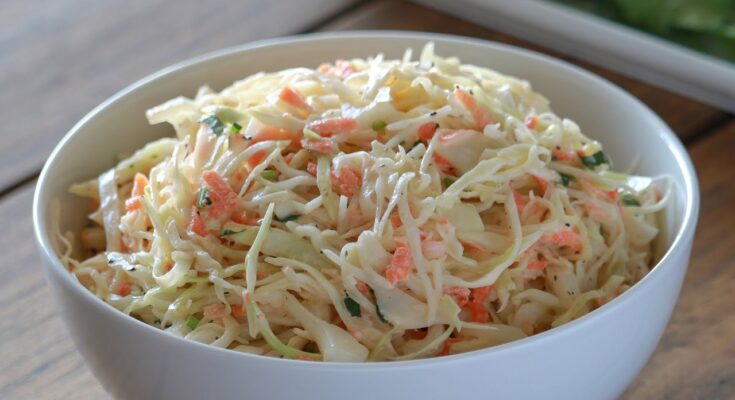Best Coleslaw Recipe: Coleslaw is one of those classic dishes that never goes out of style. Whether you’re hosting a barbecue, preparing a picnic, or just need a refreshing side dish, coleslaw is always a crowd-pleaser. Its crunchy texture, creamy dressing, and tangy flavor make it a perfect complement to a variety of main courses.
But what makes a coleslaw recipe truly the best? It’s all about the balance between freshness, creaminess, and tanginess.
In this guide, we’ll walk you through the ultimate step-by-step process to create the perfect coleslaw. From ingredient selection to preparation techniques, this article has everything you need to master this dish.
Ingredients for the Best Coleslaw
The secret to a delicious coleslaw lies in using fresh, high-quality ingredients. Here’s a complete list to ensure your dish turns out perfectly:
Vegetables:
- Green Cabbage (4 cups, shredded): The foundation of any classic coleslaw.
- Red Cabbage (1 cup, shredded): Adds color and a slight sweetness.
- Carrots (1 cup, grated): Provides sweetness and crunch.
- Onion (¼ cup, finely diced): Optional, for an extra layer of flavor.
Dressing Ingredients:
- Mayonnaise (½ cup): The base for creaminess.
- Greek Yogurt (¼ cup): Lightens the dressing and adds a tangy kick.
- Apple Cider Vinegar (2 tbsp): Balances flavors with acidity.
- Dijon Mustard (1 tbsp): Adds complexity.
- Honey or Sugar (1 tbsp): Provides sweetness.
- Celery Seed (1 tsp): Gives a unique flavor boost.
- Salt and Pepper (to taste): Essential for seasoning.
Tools and Equipment Needed
Before we start, make sure you have the right tools to make the process smooth and efficient:
- Cutting Board and Knife: For chopping and slicing vegetables.
- Box Grater or Food Processor: Speeds up shredding and grating.
- Mixing Bowls (Large and Medium): Needed for combining ingredients.
- Whisk and Spatula: Ensures the dressing is well-mixed and creamy.
- Measuring Cups and Spoons: Keeps ingredient proportions accurate.
Step 1: Preparing the Vegetables
The first step in making coleslaw is prepping the vegetables. Start with the cabbage—the star of the dish.
- Shred the Cabbage: Use a sharp knife, mandoline slicer, or food processor to shred the cabbage into thin slices. The finer the cut, the better the texture.
- Grate the Carrots: Peel and grate the carrots using a box grater or food processor.
- Chop the Onion: Dice it finely if you’re including it for flavor.
- Combine in a Bowl: Toss the shredded cabbage, carrots, and onion together in a large mixing bowl to ensure an even mix.
Pro Tip: If you want extra-crunchy vegetables, soak the shredded cabbage in ice water for 10 minutes and then drain thoroughly before mixing.
Step 2: Making the Dressing
The dressing ties the coleslaw together, and getting it right is crucial. Follow these steps to create a flavorful and creamy dressing:
- Combine Wet Ingredients: In a medium-sized bowl, whisk together mayonnaise, Greek yogurt, apple cider vinegar, and Dijon mustard.
- Add Sweetness: Stir in honey or sugar to balance the acidity.
- Season: Add celery seed, salt, and pepper to taste.
- Whisk Until Smooth: Ensure there are no lumps, and the dressing is silky smooth.
Taste the dressing before adding it to the vegetables. It should be slightly tangy, creamy, and a bit sweet. Adjust the flavors if needed by adding more vinegar, mustard, or honey.
Step 3: Mixing It All Together
Now it’s time to combine the vegetables and dressing for the final product:
- Add Dressing Gradually: Pour the dressing over the vegetable mix in small batches. Toss gently to coat everything evenly.
- Check Consistency: Add more dressing if needed, but avoid oversaturating the mix, as it can become soggy.
- Mix Thoroughly: Use a spatula or spoon to stir until all vegetables are coated evenly.
Pro Tip: Let the coleslaw sit for 5–10 minutes to absorb flavors before the next step.
Step 4: Seasoning and Adjusting the Taste
After mixing, taste your coleslaw and make final adjustments:
- Add More Salt or Pepper: If it tastes bland, a pinch of salt can enhance flavors.
- Extra Tanginess: Add a splash of apple cider vinegar.
- Sweeter Notes: Stir in a bit more honey or sugar if needed.
For added texture, consider mixing in chopped nuts, raisins, or sunflower seeds. These additions can take your coleslaw to the next level!
Step 5: Chilling and Serving the Coleslaw
Refrigerating your coleslaw before serving is a game-changer:
- Cover and Chill: Transfer the coleslaw to an airtight container and refrigerate for at least 1–2 hours.
- Garnish Before Serving: Sprinkle fresh parsley or chives for visual appeal and added flavor.
Serve it chilled for the best taste and texture. It pairs perfectly with grilled meats, sandwiches, and even tacos.
Variations of Coleslaw Recipes
Coleslaw is a highly versatile dish, and you can easily tweak it to suit your preferences. Here are some popular variations:
1. Classic Coleslaw:
- Made with mayonnaise, vinegar, and sugar for a creamy and slightly sweet flavor.
- Ideal for pairing with barbecue dishes and burgers.
2. Tangy Vinegar-Based Coleslaw:
- Uses oil and vinegar instead of mayonnaise for a lighter, tangier taste.
- Perfect for those looking for a dairy-free option.
3. Spicy Coleslaw:
- Adds heat with ingredients like sriracha, chili flakes, or jalapeños.
- Complements tacos and spicy grilled meats.
4. Asian-Inspired Coleslaw:
- Features ingredients like sesame oil, soy sauce, and ginger.
- Topped with sesame seeds or crunchy noodles for added texture.
5. Fruity Coleslaw:
- Incorporates fruits like apples, pineapples, or raisins for sweetness.
- Great for potlucks and summer picnics.
Vegan and Dairy-Free Coleslaw Options
If you’re following a vegan or dairy-free diet, making adjustments is simple:
- Replace Mayonnaise: Use vegan mayo or blended avocado for creaminess.
- Swap Yogurt: Opt for coconut or almond-based yogurt.
- Use Maple Syrup: Substitute honey with maple syrup or agave nectar.
- Add Crunch: Toss in nuts or seeds for extra texture without using dairy products.
This version is just as flavorful as the traditional one but caters to dietary restrictions.
Tips for Making the Best Coleslaw
Want to make your coleslaw stand out? Follow these expert tips:
- Use Fresh Ingredients: Fresh cabbage and carrots give the best crunch and flavor. Avoid pre-packaged mixes if possible.
- Shred Evenly: Uniform shredding ensures a consistent bite and prevents clumps.
- Chill Before Serving: Refrigerating allows flavors to meld and improves texture.
- Don’t Over-Dress: Add dressing gradually to prevent the salad from becoming soggy.
- Taste and Adjust: Always sample and tweak the seasoning before serving.
Pro Tip: Toasted nuts, seeds, or dried cranberries can add a gourmet touch.
Common Mistakes to Avoid
Even simple recipes can go wrong if you’re not careful. Here’s what to watch out for:
- Overdressing: Too much dressing can make the coleslaw soggy and overpower the vegetables.
- Skipping the Chill Time: Serving immediately doesn’t allow flavors to blend properly.
- Cutting Vegetables Too Large: Thick pieces won’t absorb the dressing well and can be harder to chew.
- Not Draining Excess Water: Wet vegetables can dilute the dressing. Dry them thoroughly after washing.
- Ignoring Proportions: Balance is key—don’t overdo vinegar or sugar, as it can throw off the flavor.
Pairing Coleslaw with Other Dishes
Coleslaw is incredibly versatile and pairs well with a variety of meals. Here are some delicious combinations:
- Barbecue Ribs or Pulled Pork: The creamy texture balances smoky flavors.
- Grilled Burgers and Hot Dogs: Adds crunch and freshness to rich meats.
- Fish Tacos: Complements the light, flaky texture of fish.
- Fried Chicken: A classic combination with Southern comfort food.
- Sandwiches and Wraps: Makes a great filling or side dish.
For a healthy twist, serve coleslaw alongside grilled vegetables or lean protein dishes.
Storing Leftover Coleslaw
Proper storage ensures your coleslaw stays fresh and tasty:
- Refrigeration: Store leftovers in an airtight container in the refrigerator for up to 3 days.
- Avoid Freezing: Mayonnaise-based coleslaw doesn’t freeze well, as the dressing may separate and become watery.
- Refresh Before Serving: If it starts to release water, drain excess liquid and stir in a bit more dressing to revive the flavor.
Pro Tip: For meal prep, store dressing and vegetables separately and mix them just before serving.
FAQs about Best Coleslaw Recipe
What is the basic ingredient list for the best coleslaw recipe?
A classic coleslaw recipe typically includes shredded cabbage, carrots, and a dressing made of mayonnaise, vinegar, sugar, and seasonings like salt and pepper. Some variations might include additional ingredients like onion, apple, or mustard for extra flavor.
How can I make my coleslaw more flavorful?
To enhance the flavor of your coleslaw, consider adding ingredients like diced apples for sweetness, celery seeds for a slight tang, or chopped fresh herbs such as parsley or dill. A splash of lemon juice or a different vinegar like apple cider can also elevate the taste.
Is there a healthier alternative to mayonnaise in coleslaw?
Yes, for a healthier alternative to mayonnaise, you can use Greek yogurt or a mixture of yogurt and light sour cream. This substitution not only reduces the calories and fat but also adds a tangy flavor profile that complements the coleslaw.
Can coleslaw be made ahead of time?
Coleslaw can definitely be prepared in advance. In fact, making it at least a few hours before serving allows the flavors to meld together more fully. However, for the best texture, avoid mixing in the dressing until a few hours before you plan to serve it to prevent the cabbage from becoming too soggy.
What are some creative ways to serve coleslaw?
Beyond serving it as a side dish, coleslaw can be used as a topping for burgers, sandwiches, or tacos for added crunch and flavor. It also pairs well as a fresh accompaniment to grilled meats and fish, providing a crisp contrast to richer dishes.
Conclusion
Coleslaw is one of those timeless recipes that fits any occasion. Whether you prefer the classic creamy version or enjoy experimenting with tangy or spicy variations, this step-by-step guide has covered all the essentials. From ingredient selection to mixing techniques and serving suggestions, you’re now equipped to make the best coleslaw right at home.
Try it out, experiment with flavors, and impress your guests with this versatile side dish. Happy cooking!



